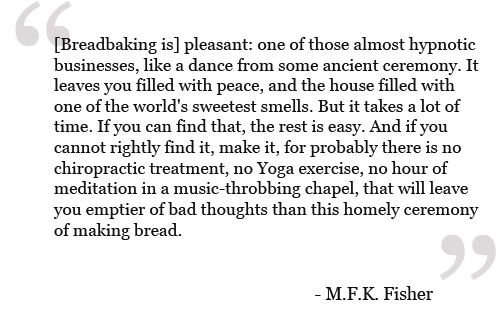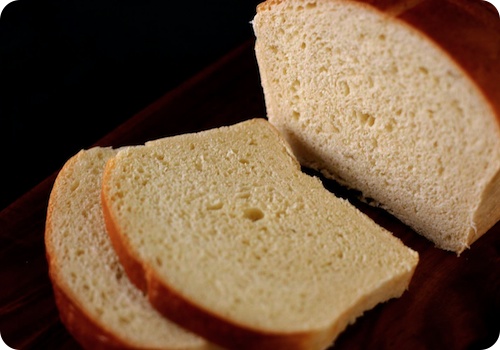The best thing: sliced bread
 Sunday, January 4, 2009 at 8:22PM
Sunday, January 4, 2009 at 8:22PM 
Quick to make, pretty tasty to boot - but not the loaf for me; Ina Garten's Honey White Bread.

To many, good bread is the cornerstone of their idea of good food. It is a basic staple of life, one that manages to not only nourish the body, but also inspires passion in the soul. The process, the crust, the crumb, the aroma, the texture, the colour, the taste ... each and every aspect of bread, its ingredients, its making, and its consumption, has been examined and often exalted.
I will not presume to think that I could add any more eloquence to its chorused praise; instead, I can only speak of how bread and its baking has become a part of the rhythm of our days.
As we are a family of bread lovers, I bake bread. To be specific, I bake bread often. Every few days, I am dusted pale with flour as I set about putting up some dough. I have made naan, I have made yeasted crescents laminated with butter, I have made soft and open-crumbled breads meant for sopping up soups and stews. I have made hearty, nubbly-textured seeded rolls. I have made foccaccia, both savoury and sweet. I have explored the personalities of rye, whole wheat and flax, of oat bran and wheat germ.
But most often, I make this. That is what my husband and I consider our bread, my variation on Jim Lahey's No Knead Bread. Yes, that bread, the one that seemed to set the entire food community a-baking in late 2006. Our version has bit of extra flour to suit the size of our cocotte, and a bit of extra salt to best suit our tastes. We have tried different flours to perfect our brand and blend. I make it without a specific measurement of water, as through our long and loving relationship I have learned the quirks of the dough's texture well enough to determine by eye how much is needed. It is not very difficult to make, but it is very rewarding.
Oh, and despite its name, I do knead it, just a bit, so that it springs back ever-so-slightly before its last rise. Every time I make it I still have a slight swell of pride at the thought that something so satisfying could come from my oven.
It is a staple, a without-thought routine of our day-to-day. This bread has often made command performances at extended family events,
in its original form and multiple grain variations.Which brings me to my dilemma. While I am more than happy to munch on a (generous) slice of this crusty boule, there does come an occasion where only sandwich-style bread will do. Pleasantly squidgy, the grocery-store classic is the stuff of many a childhood peanut butter and jelly lunch, of open-faced, gravy-soused hot turkey sandwiches made with Thanksgiving's leftovers, and the basis of a perfect grilled cheese. (Nigella Lawson specifically encourages its use for her Mozzarella in Carrozza.) There is a familiar comfort to its blandness, a charm in its yielding texture.
My trouble is, as much as this sort of bread is a standard in my memory, it is not one in my home. I just cannot seem to find a recipe that I adore. I like the Soft Sandwich Bread, American Style from Homebaking: The Artful Mix of Flour and Tradition Around the World (Random House, 2003) by Jeffrey Alford and Naomi Duguid. I have made it rather often, with our eldest son Benjamin taking delight in the loaves as they rise on a sunny windowsill. It a pre-fermented starter called a biga, which adds a deeper complexity to the final product. But, as delicious as this bread is, it did not stop me from trying my hand at other versions.
My most recent attempt was Ina Garten's Honey White Bread, from Barefoot Contessa at Home (Random House, 2006). My affection for Garten's recipes is nothing new; and this one looked a treat. Garten's recipe left most of the work to a stand mixer, with minimal hands-on effort required. And although I do enjoy a bit of kneading, it seemed novel to allow the machine to do the heavy labour. After a whirl around the mixer, it took only a few turns for the dough turn silken under hand. Into the buttered bowl it went, rising up enthusiastically after an hours rest. I punched it down, formed two generous loaves and waited again. I was convinced that Garten's assurance of "foolproof good bread" would deliver me to sandwich nirvana. But alas, I was left unsatisfied.
Now that is not to say that this is not a good bread. In fact, I am sure that many people would hazard to say that it is great. After baking, the loaves emerged bronzed and beautiful, with a proud, Dromedarian hump. When sliced, they were soft, pleasantly dense, with an even-textured and tight crumb.
Where I was disappointed was the taste.
Maybe it is just me, but while I appreciate the relative brevity of its preparation (just under three hours from start to finish), the amount of leavener and honey used to achieve that speed were all-too-evident in its sweet, yeasty flavour. This, coupled with the richness of egg yolks and butter, resulted in a bread that would surely be perfect as a substitute for challah or brioche for pain perdu or summer pudding, but seemed distractingly-sweet when eaten alone. It just was not what I was looking for.And so, it was back to my boule for us and back to the recipe books for me. And although there is a half a loaf in our breadbox just now, I am still thinking of the perfect sandwich loaf. I am more than open to suggestion, and any guidance would be appreciated and welcomed.

Honey White Bread
From the book Barefoot Contessa at Home by Ina Garten.
The recipe can be found online.
 Barefoot Contessa,
Barefoot Contessa,  Ina Garten,
Ina Garten,  baking,
baking,  bead,
bead,  breakfast,
breakfast,  help,
help,  lunch,
lunch,  recipe,
recipe,  request,
request,  snack
snack 
















